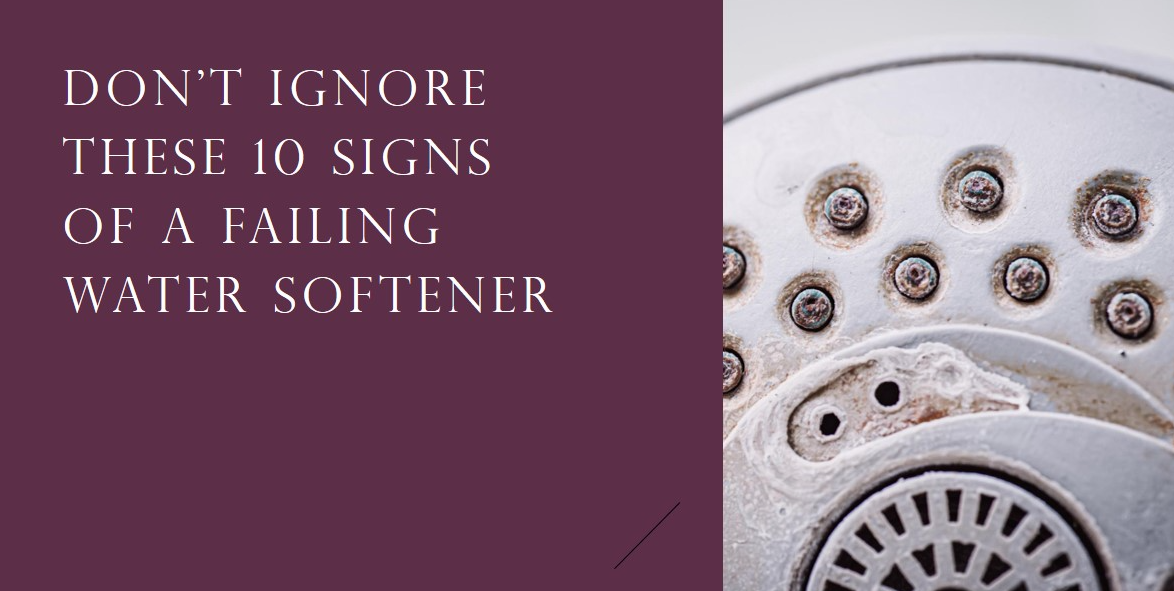If you have a water softener system installed in your home, it provides essential benefits like reducing scale buildup, preventing damage to plumbing and appliances, and leaving your skin and hair feeling softer after bathing. However, water softeners can fail over time for various reasons. Being able to recognize the signs of a failing water softener is crucial so you can have it repaired or replaced before the issues become severe.
What Causes a Water Softener to Fail?
There are several potential causes for a water softener to stop functioning properly:
- Age of the system – Water softeners can last 8-12 years on average before needing replacement. Older systems are more prone to breakdowns.
- Insufficient maintenance – Lack of periodic maintenance like replacing filters, sanitizing resin beads, and refilling salt can lead to premature failure.
- Power outages – Frequent power interruptions can damage softener components like valves and control boards.
- High water usage – Water softeners that must work overtime to handle the needs of a large household will tend to wear out faster.
- Water quality issues – Harsh water that’s very hard or contains high levels of iron, manganese or sulfates can decrease softener lifespan.
- Incorrect installation – Mistakes during installation can prevent the system from working efficiently right from the start.
10 Common Signs Your Water Softener is Failing
Watch out for these 10 warning signs that indicate your water softener needs repair or replacement:
1. Decrease in Water Pressure
Water softeners require adequate water pressure to push water through the resin beads for ion exchange to take place. A drop in water pressure means the softener is having trouble with this process. Clogged resin beads or control valve issues can cause low pressure.
2. Return of Hard Water Symptoms
If you notice scale accumulating on fixtures again, mineral spots on dishes or bathtubs, stiff laundry, and dry skin after showering, your softener is not removing hardness minerals from the water properly. Malfunctioning resin beads are often the culprit.
3. Salt Tank Not Emptying
Salt levels remaining unchanged for long periods imply that regeneration isn’t happening as it should. Something is preventing the brine solution from being drawn into the resin tank during regeneration.
4. Softener Frequently Regenerating
Frequent regeneration cycles point to an issue with the control valve or water usage calculations. This leads to inefficiency and salt wastage. Excess water in the brine tank can also trigger abnormal regenerations.
5. Leaking Tanks
Cracks in the brine tank or softener tank will result in salt, water or resin beads leaking. This deterioration is caused by normal wear or freezing temperatures. A leak indicates tanks need replacement.
6. Noisy Operation
Unusual noises like banging or grinding sounds point to defective control valves. The same issue causes tanks to vibrate during regeneration. Replace valves and inspect other components like rotors and distributors.
7. Cloudy Water
Resin beads coming loose from the tank due to backwashing issues or a cracked softener tank cause cloudiness in conditioned water. Replace damaged components and disinfect the system.
8. Bad Tasting/Smelling Water
Foul odors or tastes signify contaminated resin from bacteria or mold growth. Neglected sanitization and maintenance leads to contamination. Resin cleaning or replacement is required.
9. Damaged Piping and Appliances
If your water softened correctly, it shouldn’t corrode plumbing or appliances. Rust spots and accelerated corrosion indicate flaws in the softening process. Inspect all system components.
10. Increased Energy Bills
A water softener in disrepair operates less efficiently and can end up increasing your electric bill. Look for other malfunction signs and have an expert examine the system.
Dangers of Using a Failing Water Softener
It’s not just an inconvenience when your water softener stops working properly. Using a defective system can negatively impact your home, health, and wallet in various ways:
- Hard water minerals quickly accumulate in pipes, water heater, appliances, etc. when not properly softened. This leads to scale buildup and corrosion damage over time.
- The resin beads in the softener become overwhelmed when the system cannot regenerate and cleanse itself. Hardness minerals remain in the water supply instead of being removed.
- You must deal with the hassles of hard water again – mineral deposits, dull laundry, stiff hair, and dry skin. Soap and detergent also becomes less effective.
- Bacteria and mold can colonize the softener if resin beads are not sanitized periodically. Contaminated water entering your household poses health risks.
- A defective unit must regenerate more frequently which uses more water, salt, and electricity. Repair and replacement costs add up too.
- Malfunctioning components like valves and distributors mean the softener operates inefficiently and excessive strain decreases lifespan.
- Water leaks from faulty seals, gaskets, or tanks cause salt, resin, and water damage. Mold and sinkhole risks increase.
How to Test Whether Your Water Softener is Working
Start with simple tests to evaluate your softener’s performance before calling in a professional:
Check for salt bridging – Use a broom handle to poke holes in the salt to ensure it’s fully dissolving in the brine tank. Bridged salt prevents brine formation.
Test your water hardness – Use test strips or kits to measure grain hardness before and after the softener connection and compare. Properly softened water should test less than 1 grain per gallon.
Examine conditioned water – Check for clarity and taste. Softened water should not be cloudy, smelly, or salty tasting. Discoloration and odors indicate issues.
Note pressure differences – Compare pressure at a tap fed by the softener versus an unsoftened direct line. Significantly less pressure points to softener malfunction.
Check regeneration schedule – Initiate a manual regeneration cycle and verify it completes fully. Record if it takes longer than usual.
Consider volume usage – Estimate household water usage to determine if low capacity could be limiting your softener’s effectiveness.
Professional Water Softener Repairs
If your diagnostic tests reveal that your water softener is indeed failing to soften water adequately, contact professional service technicians rather than attempting DIY repairs. Trained softener experts have the skills and tools to:
- Troubleshoot the issue and accurately diagnose what part of the system is malfunctioning.
- Open the softener tanks safely to inspect and clean the resin beads. Proper resin bed maintenance is crucial.
- Replace defective parts like seals, control valves, distributors, and media tanks.
- Adjust water usage settings and reprogram electronic controls to optimize softener function.
- Sanitize all softener components and flush the system to restore performance.
- Bypass the softener completely in case of emergencies requiring immediate cut-off.
- Handle complex repairs beyond do-it-yourself abilities.
- Provide warranty and guarantee on repair services.
When to Purchase a New Water Softener
If your water softener is over 10 years old and experiencing multiple performance issues, purchasing a new system altogether is likely the better investment, rather than sinking money into repairing an outdated model.
Newer softener systems are more efficient, convenient, and tailored to handle today’s water treatment needs. Key upgrades include:
- Improved valve design – New valves are more reliable and less prone to malfunctioning. Maintenance needs decrease as well.
- Advanced electronics – New microprocessors and control boards optimize settings, consumption, and regeneration frequency.
- Remote accessibility – Mobile apps allow monitoring usage, adjusting settings, and activating regeneration remotely.
- User-friendly interfaces – Intuitive and simplified touchpad controls replace confusing buttons and displays.
- Demand-initiated regeneration – Sensors determine when regeneration is truly necessary based on usage rather than a fixed schedule. This saves water, salt and energy.
- Higher resin bead quality – Newer resin types have increased hardness removal capabilities and lifespans with proper maintenance.
- Better brine systems – Improved designs prevent salt bridging and precisely calibrate brine concentration.
- Fleck valve upgrades – The latest Fleck valve models resolve vulnerabilities of previous versions.
Key Takeaways: Recognizing Failing Water Softener Signs
- Monitor for reduced water pressure, return of hard water symptoms, salt tank issues, abnormal regeneration cycles, and leaks to catch softener failures early.
- Strange noises, cloudy water, bad tastes/odors, corroded plumbing, and increased energy bills also indicate problems.
- Test your water’s hardness, appearance, pressure, and the softener’s regeneration function to confirm issues.
- Repairs by qualified technicians are recommended once a failing softener is identified. DIY repairs are risky.
- Consider investing in a new, more technologically-advanced softener model rather than repairing units over 10 years old.
Frequently Asked Questions
How can I make my water softener last longer?
Regular maintenance is key to maximizing your water softener’s lifespan. Follow the manufacturer’s instructions for cleaning and sanitizing the resin beads and tanks annually. Also check and refill salt levels monthly, replace filters on schedule, and keep the softener electronics dry.
Why is my water softener using so much salt?
Excessive salt consumption usually indicates that the brine tank concentration being drawn into your softener is too dilute. A professional can adjust brine valve settings and clean the injectors to optimize salt usage. Signs of salt bridging or mold in the brine tank can also lead to waste.
Can I clean my own softener resin tank?
It’s not recommended. Proper resin cleaning involves completely purging the beads from the tank for thorough cleaning, sanitization and replacement. The average homeowner does not have the tools or technical know-how to handle this process safely. Leave it to the experts.
What should I do if the resin beads are visible in my water?
Visible resin beads in your water is a sign of a major internal problem like a cracked tank. Shut off the water supply to your softener immediately and call for professional repair. Don’t attempt to use a system with damaged tanks or pipes.
Why does my water softener drain at night?
Most water softeners are pre-programmed to initiate regeneration cycles at night when water usage is lower. This allows tanks to refill with softened water before the household wakes up needing water the next morning. The process typically takes 1-2 hours.
Diagnose Issues Promptly for Optimal Water Softener Operation
Being aware of the likely signs your water softener is failing you allows you to take action promptly. Otherwise, a deteriorating system will continue working inefficiently while causing water quality and household issues. Catching problems early also minimizes repair requirements and associated costs. With routine maintenance and timely repairs when needed, your water softener can continue providing properly softened water for years before replacement is necessary. Contact a water treatment professional whenever you suspect your softener needs service.


